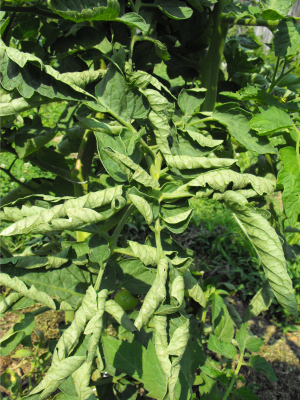One of the traits NOVIC requested data for was the severity of leaf curl (or leaf roll) in the varieties. This evaluation occurred during vegetative growth while plants were in early bloom (July 20th) on a 1-5 scale after a whole-plot visual assessment. 1= No or minimal leaf curl, 3= Noticeable leaf curl (upward cupping of leaflet margins especially in older leaves), and 5= Severe leaf curl (tight inward rolling of leaflets exposing abaxial surface on both new and old leaves). This type or ranking is ordinal data, and our varieties are nominal. The appropriate statistical tests are going to be goodness of fit tests (chi squared).
The point of evaluating leaf curl is not explained in the NOVIC protocol. My best guess is two-fold: 1.) leaf curl plays a role in how exposed fruit are, and 2.) quantitative trait loci (QTLs) controlling leaf curl in tomato relatives have been correlated with late blight resistance (more on this in my spring paper).
Leaf Curl by Variety
Pearson’s chi square analysis gave a value 36.74 (P=.12), which indicates no significant differences exist. Pearson’s chi square, however, is suspect when your sample size is small and compounded by small data numbers. Since I scored by block and only evaluated once, the sample size is indeed small. To get more confidence in the results with the small sample size, I also ran a Fisher’s Exact test in JMP. The P value again was .12, so no significant differences were detected for leaf curl. In retrospect, I could’ve easily scored individual plants and had a better sample size. (These kind of mistakes are nice to make as an undergrad.)
Leaf Curl by Block
Our field has some serious variability when it comes to sun exposure, since we have a forest to the south. At certain times of the year, this field is 80% shaded (a factor in such late ripening, I think). Since data was collected by plot, it was possible to analyze leaf curl by block. Pearson’s chi-square, with a value of 3.61 (P=.46), and Fisher’s Exact test (P=.49) supported no detectable significant differences.

Leave a Reply